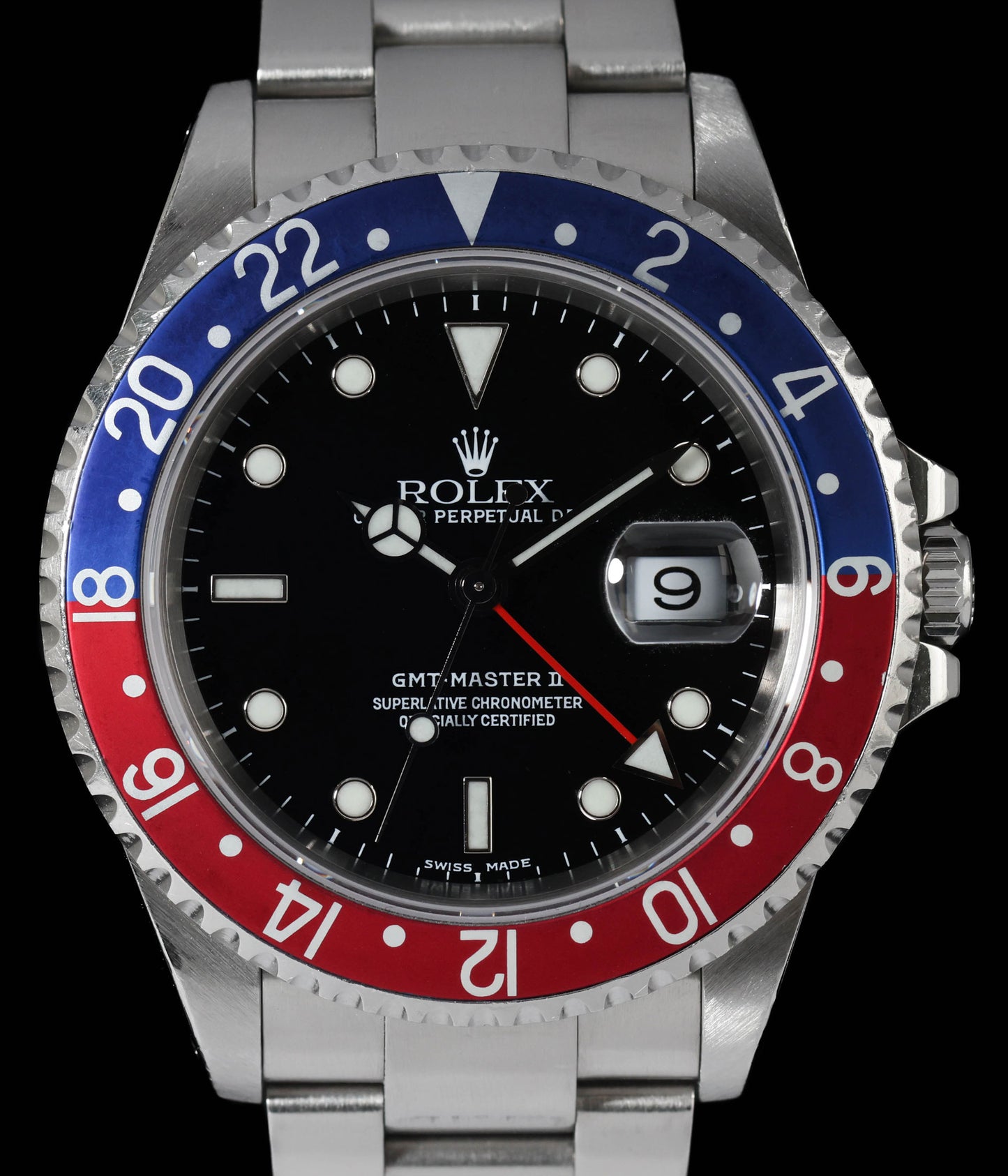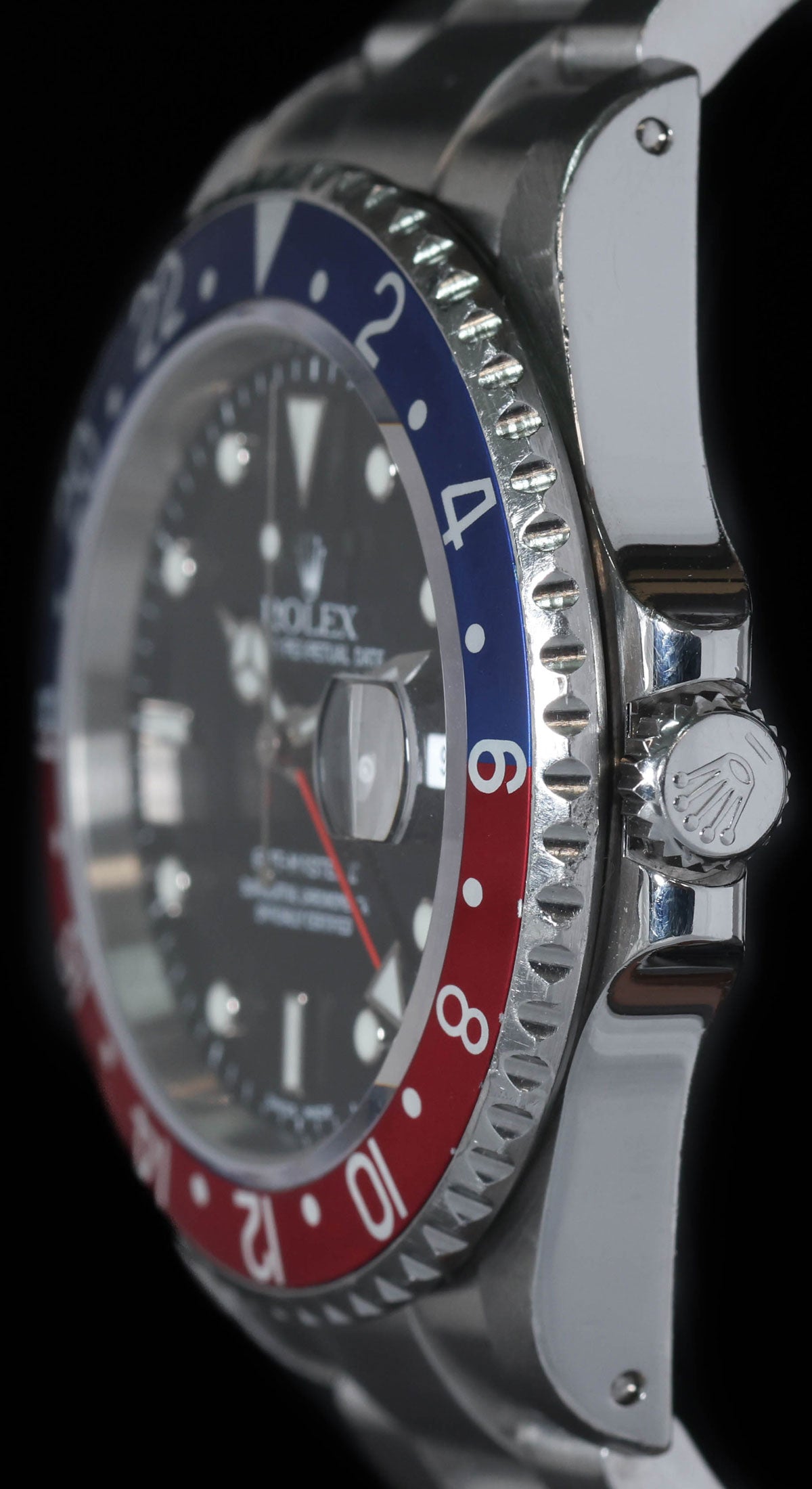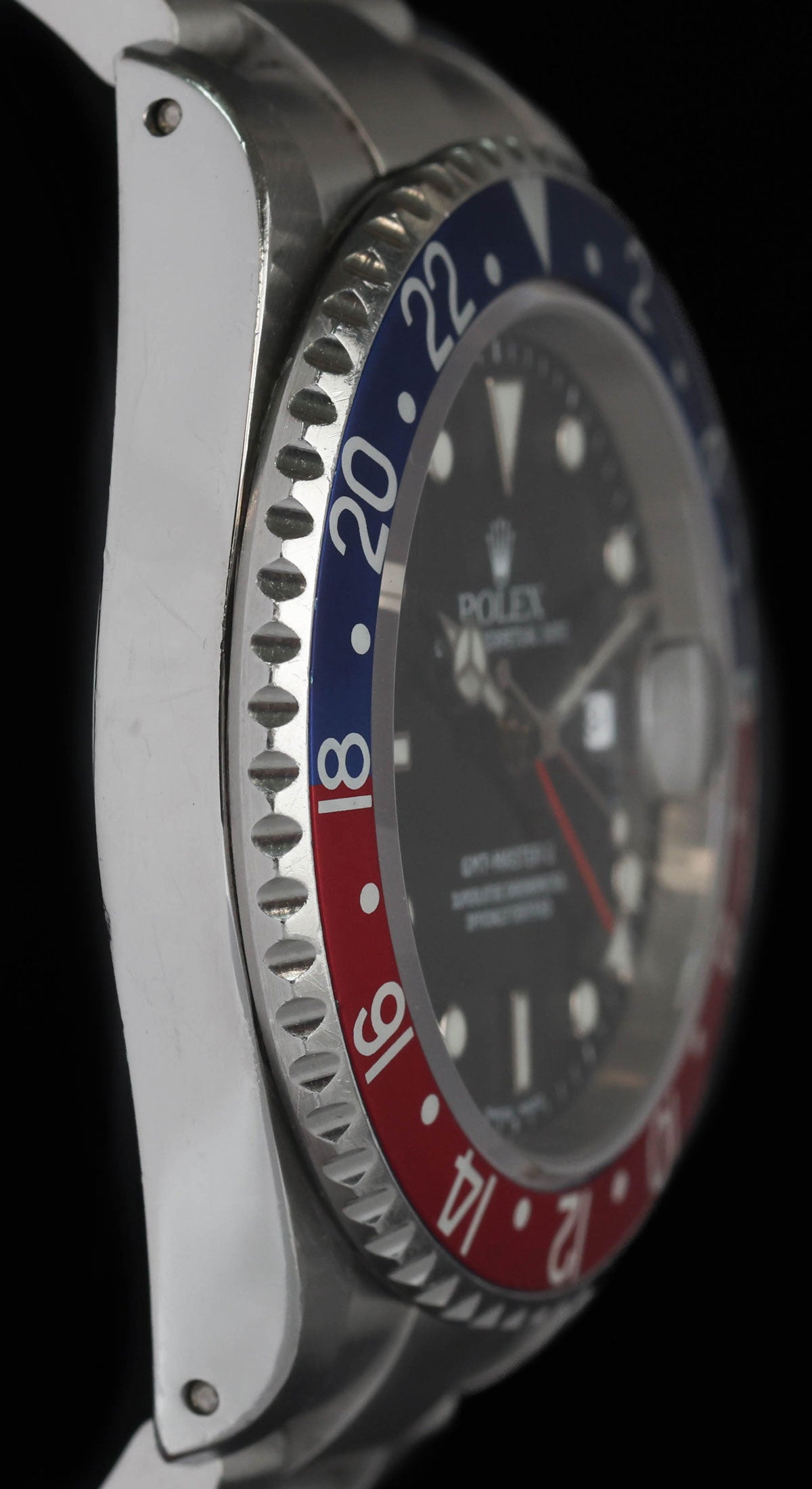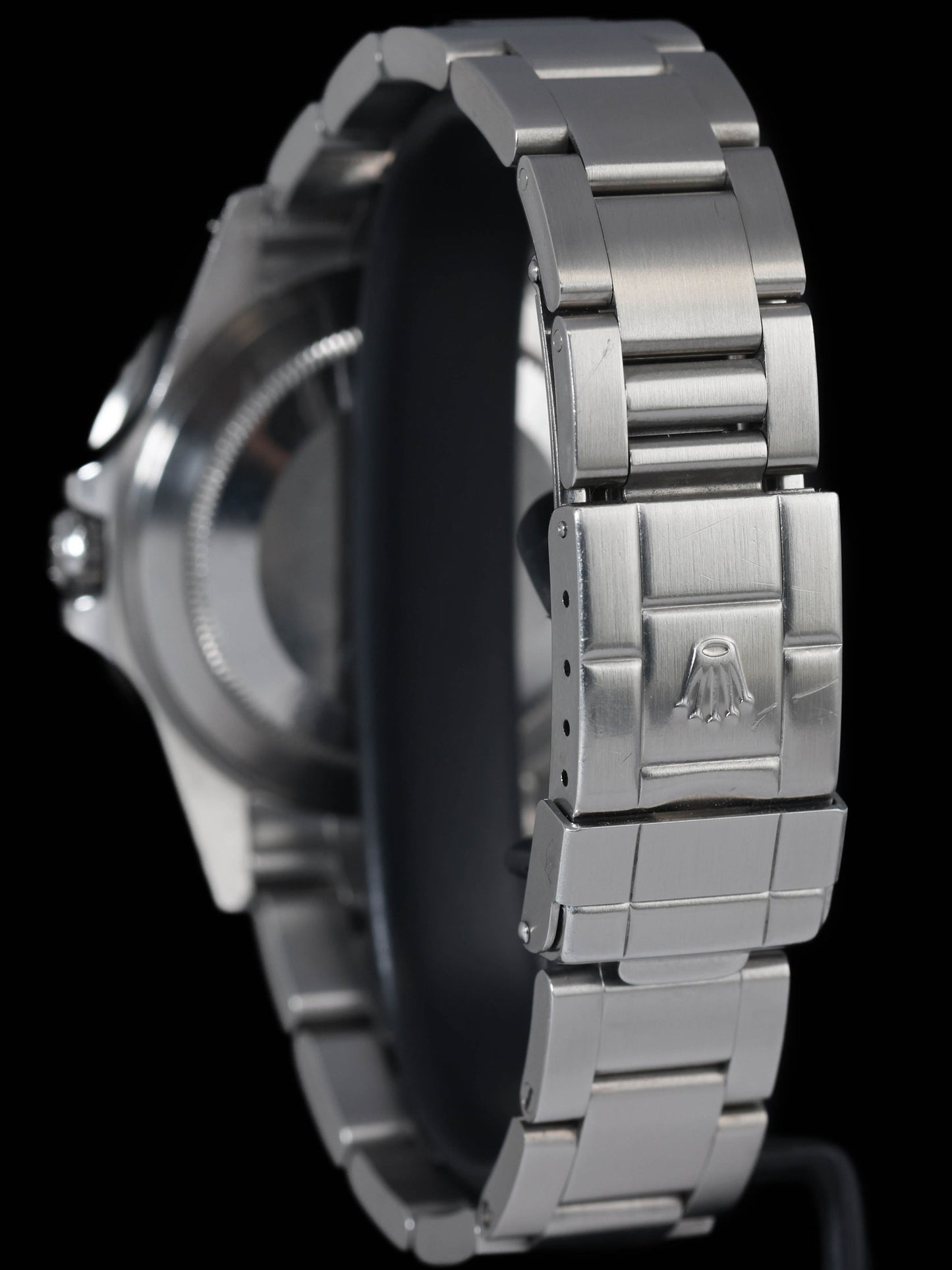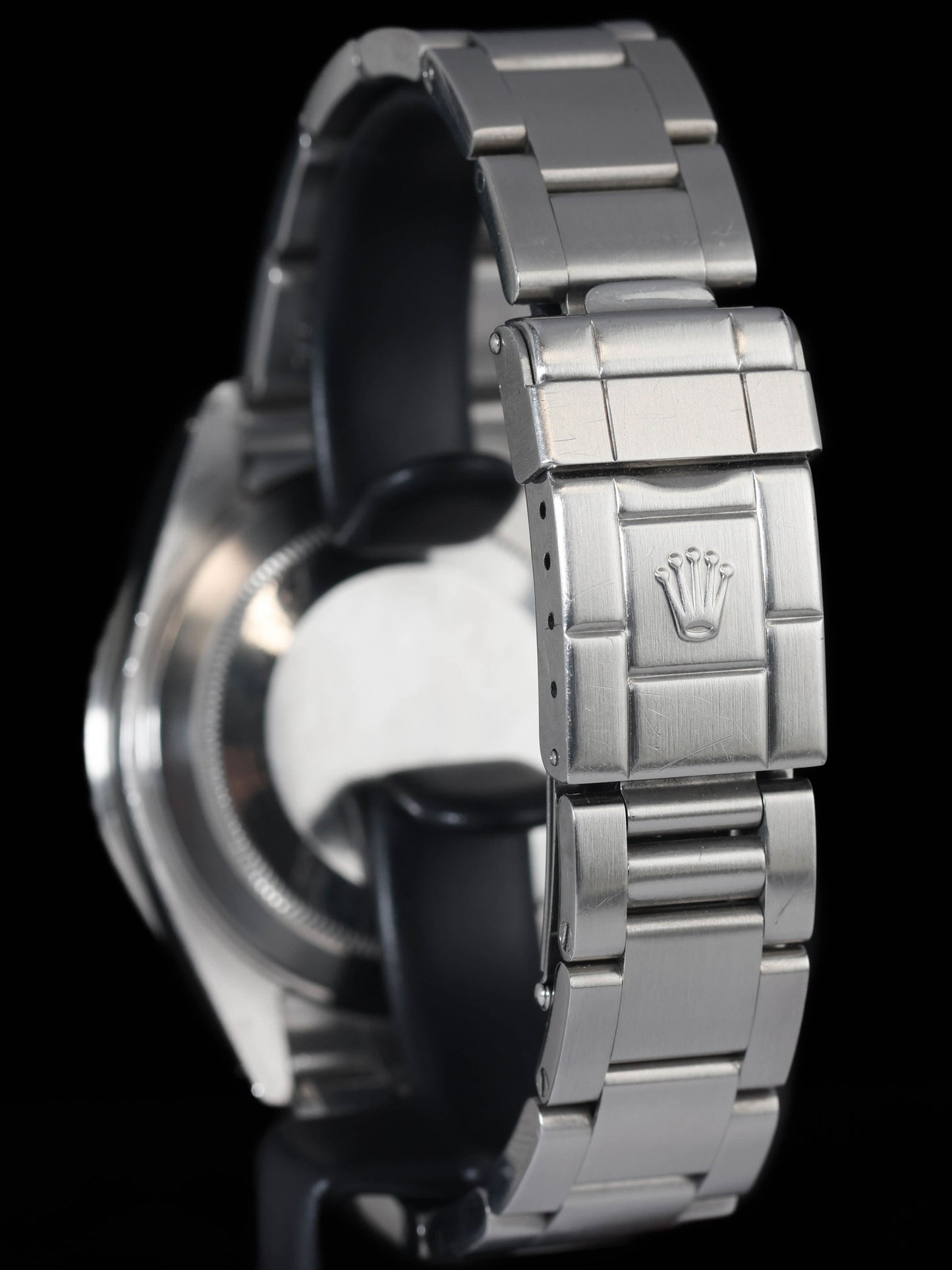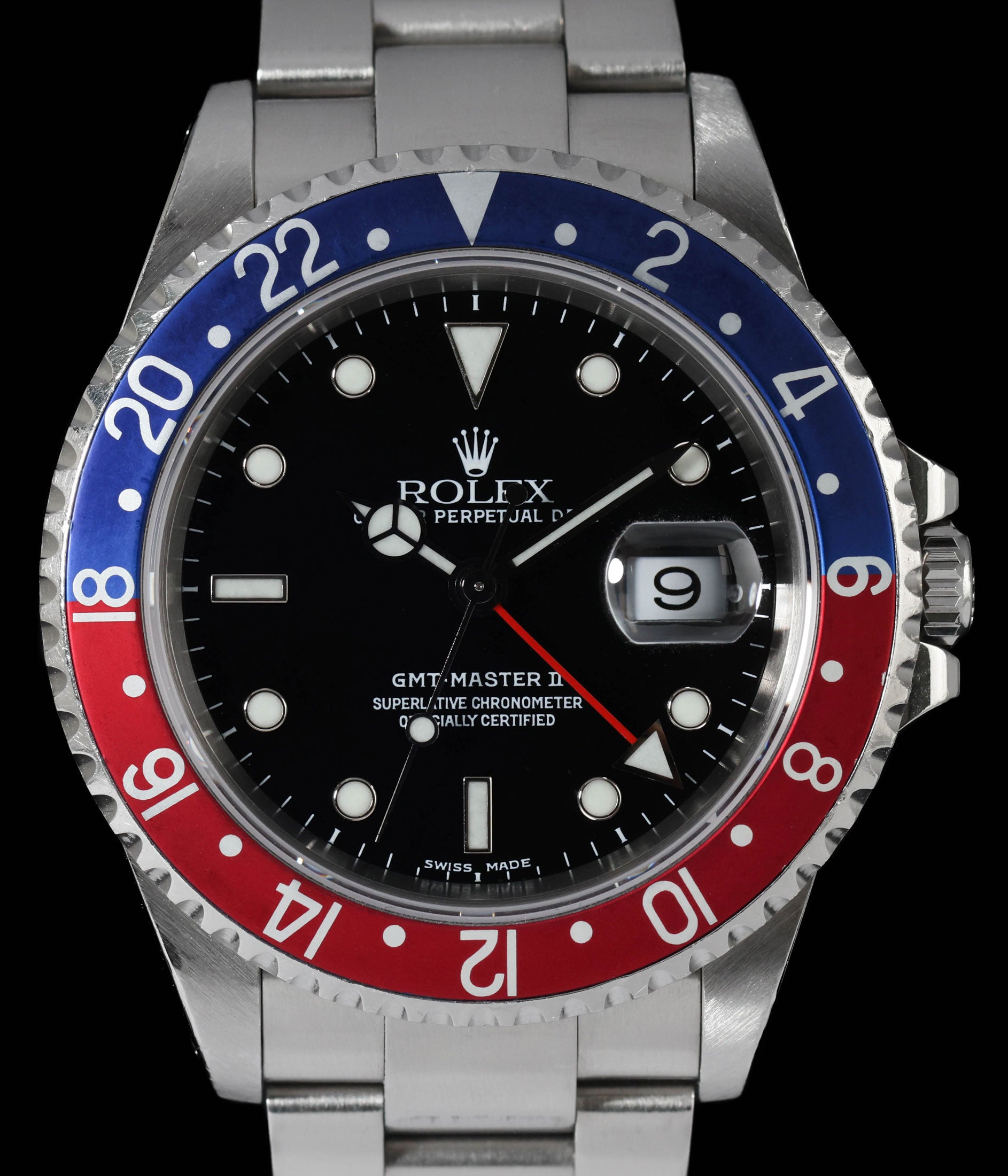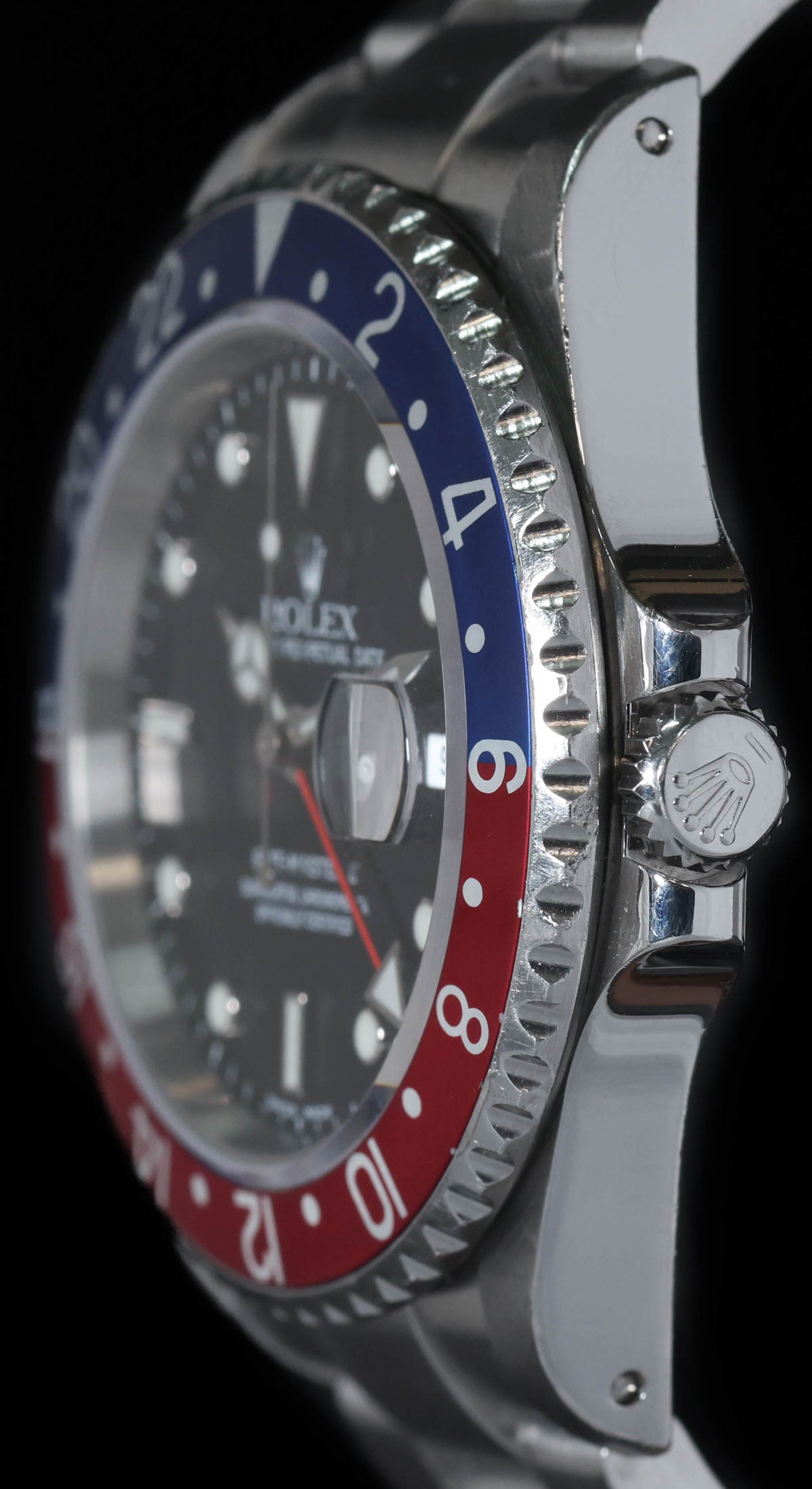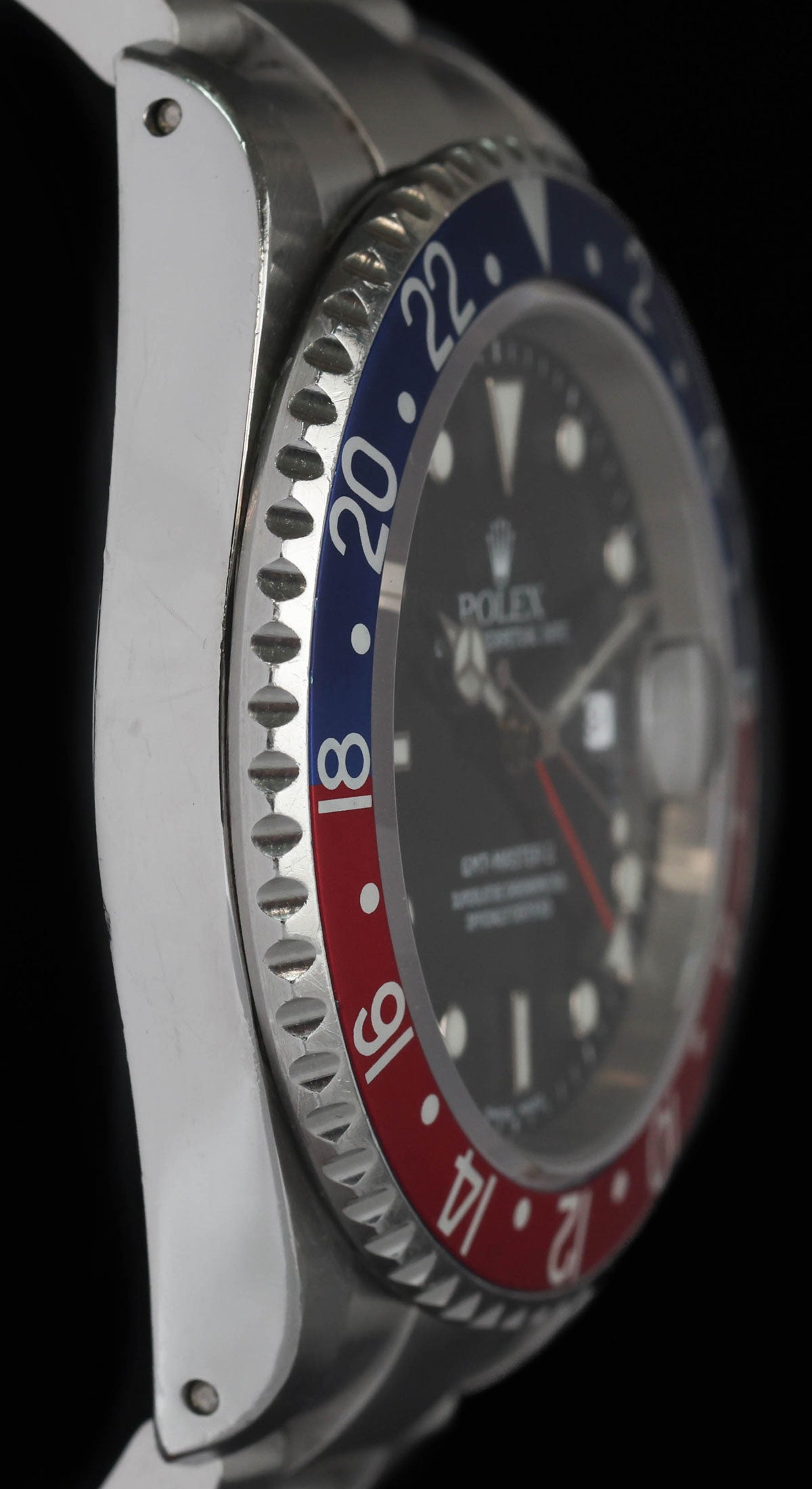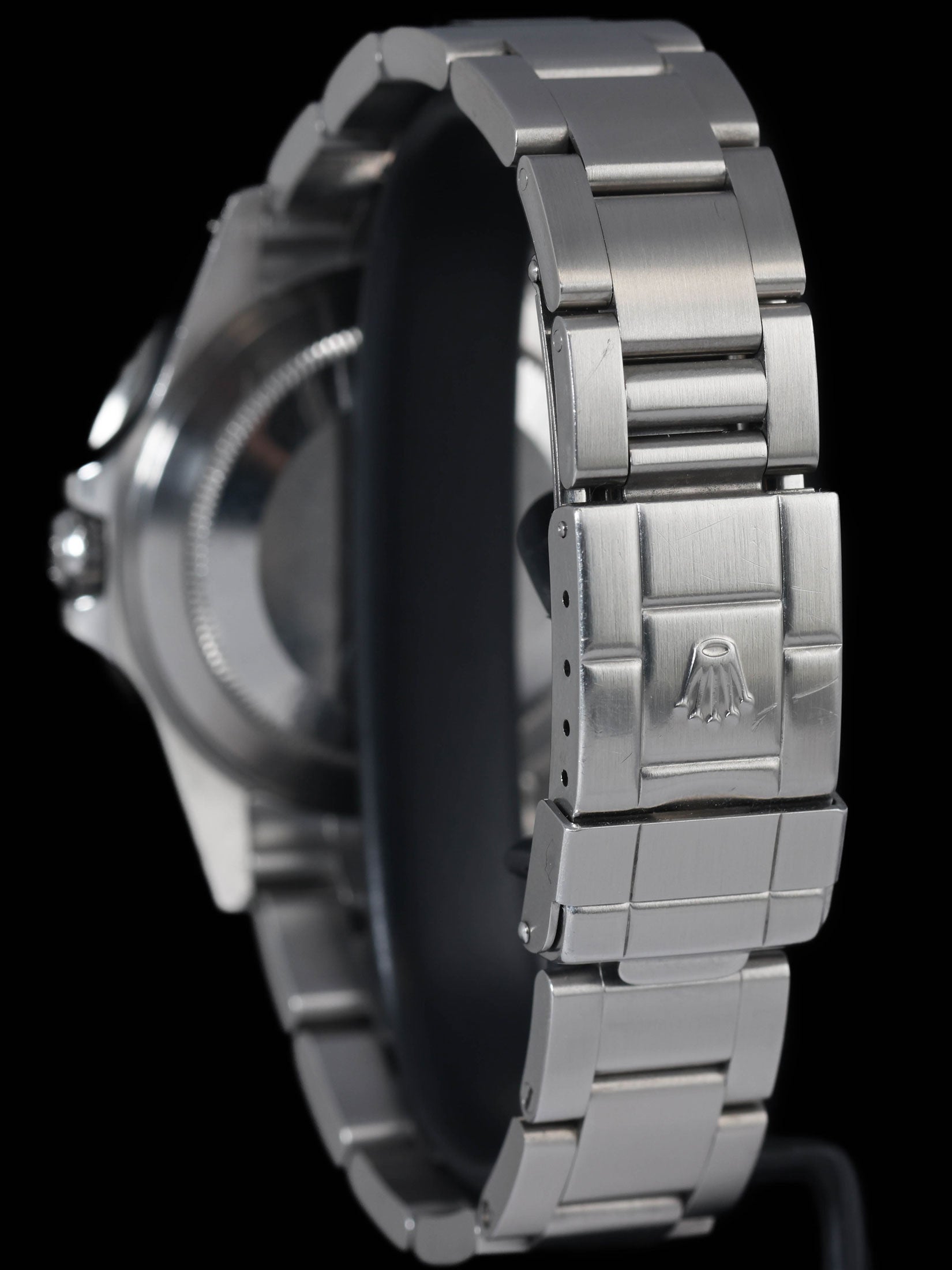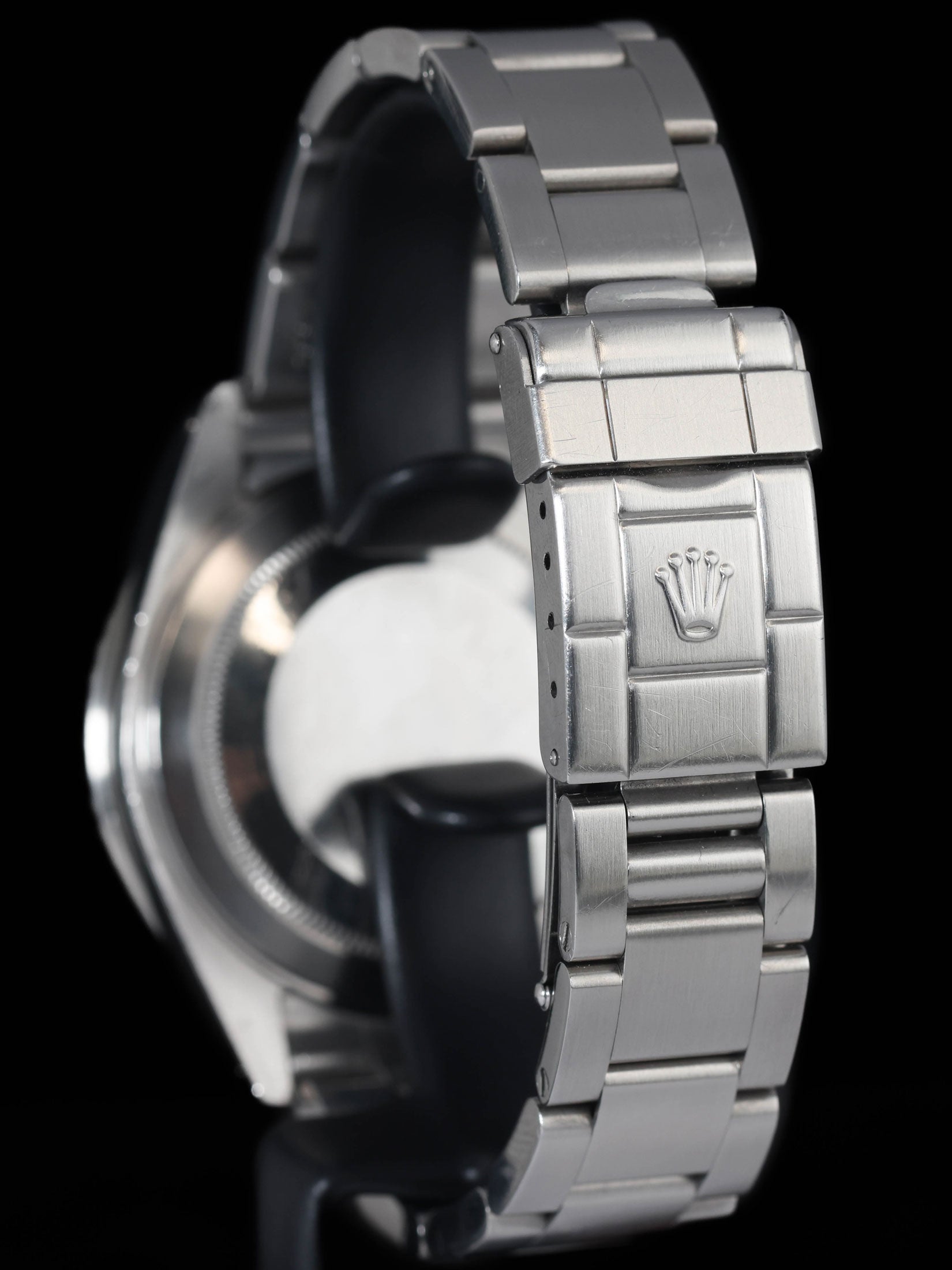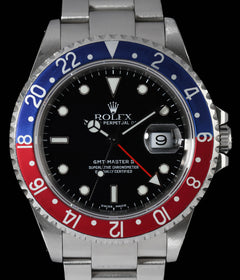Crown Vintage
Rolex GMT Master II 16710 'Pepsi' 40MM 2000
Rolex GMT Master II 16710 'Pepsi' 40MM 2000
Couldn't load pickup availability
Rolex GMT Master II 16710 'Pepsi'
Case presents in good overall condition with sharp lugs and clearly defined chamfers. A single small dent is visible on the non-crown (nine-o’clock) flank but remains unobtrusive when worn. Dial and hands are flawless, showing clean surfaces, original printing and intact lume with no signs of retouching or degradation. Overall, a well-preserved example requiring no immediate cosmetic attention.
Share
Why we love this watch
Why we love this watch
Rolex GMT-Master II 16710 ‘Pepsi’
At the turn of the millennium, Rolex was refining—rather than reinventing—its flagship dual-time watch. The GMT-Master II reference 16710, leaving Geneva in 2000, kept the bright red-and-blue aluminium bezel that had guided airline crews since the jet age, but combined it with an independent local-hour hand, Luminova lume and a slimmer case than its immediate predecessor. It stands as the last classic iteration before the era of maxi lugs and ceramic, offering today’s traveller a robust tool that still slips beneath a shirt cuff and tracks three time zones without a smartphone.
Origins of the GMT-Master II Evolution
The story starts in 1954 when Pan Am asked Rolex for a cockpit watch that could show both home and destination time. Reference 6542 met that need but forced pilots to rotate the bezel for every zone change. By 1983, expanding route maps demanded a quicker solution, so Rolex introduced the GMT-Master II 16760 “Fat Lady” with calibre 3085; its jumping local-hour hand let wearers adjust to a new city in seconds.
The 16710 arrived in 1989 and trimmed the bulk. With calibre 3185 the movement height fell, the case narrowed and the bracelet regained its elegant taper. Three bezel options—Pepsi, black-and-red “Coke” and all-black—catered to varied tastes, yet the classic red-and-blue remained the sales leader. Across an 18-year run Rolex introduced incremental changes: tritium gave way to Luminova in 1998; solid end links appeared in 2003; lug holes vanished in 2003-04; and the laser-etched coronet debuted on the crystal in 2001. A watch built in 2000 combines Luminova, drilled lugs, hollow end links and no laser coronet—a snapshot of transition.
The Millennial Reference in Context
A piece leaving the factory in early 2000 bears a “Swiss” dial, while those assembled later read “Swiss Made” as Rolex migrated to Super-Luminova. Either way, night-time legibility improved dramatically over low-glow tritium. The aluminium insert stayed bright and light, accepting vivid dyes through anodisation that ceramic could not yet match. Owners soon noticed gentle fading—navy drifting toward sky blue, crimson mellowing into raspberry—adding individuality without compromising clarity.
Rolex continued to mill cases from 904L stainless steel, prized for resistance to pitting in tropical humidity. Compared with earlier 316L, it takes a higher polish yet shrugs off chemical attack from jet-fuel vapour and salt spray. Water-resistance stayed at 100 metres, more than sufficient for a post-meeting swim in the hotel pool.
Case and Bezel Architecture
Measuring 40 mm across the bezel and 12.4 mm thick, the 16710 is remarkably svelte for a sports Rolex. Shoulders with drilled lug holes emphasise its tool-watch DNA and enable fast strap swaps. The bidirectional bezel employs 120 firm clicks, letting the wearer track a third time zone by rotating the red-to-blue insert against the 24-hour hand. Anodised aluminium keeps weight low and curbs cockpit glare.
Under the sapphire crystal a narrow steel rehaut meets the dial cleanly; the engraved inner bezel seen on later references was still a decade away. The Triplock crown screws down on triple gaskets, and the screwed case-back’s large flutes make factory servicing straightforward.
Calibre 3185: Engine of Precision
Powering the watch is calibre 3185, an in-house automatic with 31 jewels, a 28,800 vph beat rate and a 50-hour reserve. A full balance bridge and free-sprung Glucydur balance enhance shock stability, while Microstella screws permit fine timing without a regulator arm. The over-coil hairspring breathes concentrically, maintaining amplitude whether the wearer is desk-bound in New York or climbing into a night flight to Los Angeles.
Most important is the jumping local-hour mechanism. Pulling the crown to the first position disengages the hour wheel, allowing the hand to advance or retreat in one-hour steps; the date jumps forward or back accordingly. The seconds hand keeps running, so chronometer accuracy remains intact after multiple legs. Frequent travellers also appreciate that the 24-hour hand remains linked to the minute hand, preserving a reliable reference time.
Dial, Hands and Lume
The dial is glossy black, its scripted white print crisp and economical. Applied white-gold surrounds frame the round, baton and triangular plots, preventing corrosion and lending subtle contrast. Mercedes hour, pointed minute and lollipop seconds hands are polished steel, while the fourth hand is painted red and tipped with a luminous triangle. Luminova (or Super-Luminova on late-2000 pieces) glows green for many hours—handy during dim cabin approaches when phone screens must be dimmed.
A date aperture at three o’clock sits beneath the Cyclops magnifier. Its bevelled frame merges cleanly into the glossy surface—evidence of Rolex’s steady pursuit of manufacturing tolerances long before “industrial chic” became a marketing slogan.
Bracelet and Wearing Feel
Rolex paired the 2000 watch with Oyster bracelet reference 78790. Hollow end links hug the case, and brushed centre links avoid unnecessary flash in conservative boardrooms. The bracelet tapers from 20 mm to 16 mm, and the stamped clasp carries a flip-lock plus secondary safety catch. Although later solid-link bracelets feel stiffer, this lighter build balances the head evenly, preventing watch-roll on smaller wrists. The 16710 stays comfortable through a full day of airport transfers.
Later in the decade Rolex upgraded the clasp with an Oysterlock featuring a machined safety bar and solid end links, yet many owners favour the fluid feel of the earlier bracelet. Pin-through link construction makes home sizing straightforward with a single screwdriver, and the stamped blades articulate smoothly around the wrist. In short, the bracelet embodies the same philosophy as the watch head: robust functionality without unnecessary bulk.
For collectors, the year-2000 reference sits neatly between the high-gloss tritium dials of the early 1990s and the late-era solid-link bracelets. It offers Luminova practicality without losing the classic drilled lugs and thin-font bezel that define older GMTs. Because Rolex produced the Pepsi and Coke variants concurrently, period catalogues highlight how the brand positioned colour as a functional aid rather than a fashion statement. The fact that professional airline crews still relied on the reference underlines its credibility.
Everyday Utility for Long-Haul Travellers
For globe-trotters, crossing time zones is routine—whether hopping between regional hubs or making a 14-hour trek across continents. Setting the local hand takes seconds and, because the date follows that hand, no mental arithmetic is required when you land before you left. Rotating the bezel lets you monitor project deadlines in London while retaining UTC on the 24-hour hand.
Seasoned flyers develop rituals around the watch. Before push-back from a Pacific departure city, the bezel is rotated to align with Honolulu so that crew rest breaks can be coordinated. On arrival, a quick click of the crown sets local time forward or back, and the 24-hour hand continues to mark UTC for log-book entries. Those working irregular hours at remote outposts adopt a similar routine, keeping head-office time on the bezel while aligning the local hand to the site’s roster.
Beyond aviation, the 16710 serves as an unobtrusive travel diary. Subtle bezel fades and bracelet scratches record destinations visited—each a visual postcard that accrues character rather than detracts from value. The watch rewards ownership through experience, not protective storage.
Because the watch is mechanical, it is immune to airline requests for “flight mode” and does not panic when an airline app fails. A fresh crown seal gives peace of mind for a post-conference snorkel in warm coastal waters. On land, the bezel can double as a crude countdown—align zero at the triangle to track a parking meter or speech duration. In the cockpit, bezel colours serve a purpose: red hints at daylight hours, blue at night, offering at-a-glance orientation on long-haul polar routes where sunrise and sunset blur.
Final thoughts
The Rolex GMT-Master II 16710 ‘Pepsi’ from 2000 captures a sweet spot between vintage charm and modern convenience. Its case proportions recall mid-century models, yet the independent hour hand, sapphire crystal and corrosion-proof steel make it perfectly suited to contemporary life. Aluminium inserts fade gracefully, drilled lugs allow versatility, and calibre 3185 keeps dependable time without fuss.
Twenty-five years on, the watch remains a companion—a practical instrument built to accompany long journeys rather than hide in a safe. Slip it beneath a cuff and it disappears until needed; glance at the bezel colours and you know instantly whether the team in Tokyo is awake. In a market crowded with oversize ceramics and marketing-driven limited editions, the 16710 offers travellers and desk pilots alike a quietly confident alternative—one that values functionality over fireworks and endures precisely because of that restraint. It is, simply, a reliable ally for life’s journeys. On a personal note, I’ve worn a GMT Master on long-haul flights. It’s reassuring to glance at a watch that never needs ‘flight mode’ and can’t run out of charge.
Case & Bracelet
Case & Bracelet
- Case in good condition, lugs sharp, chamfers visible.
- Small Dent in non crown side of case.
Dial & Hands
Dial & Hands
Dial and hands are flawless.
Warranty & Condition
Warranty & Condition
Crown Vintage Watches provides a minimum 3-month mechanical warranty on pre-owned watches, from the date of purchase.
The warranty covers mechanical defects only.
The warranty does not cover damages such as scratches, finish, crystals, glass, straps (leather, fabric or rubber damage due to wear and tear), damage resulting from wear under conditions exceeding the watch manufacturer’s water resistance limitations, and damage due to physical and or accidental abuse.
Please note, water resistance is neither tested nor guaranteed.
Shipping and insurance costs for warranty returns to us must be covered by the customer. Returns must be shipped via traceable courier. Return shipment must be pre-paid and fully insured. Collect shipping will be refused. In case of loss or damages, the customer is liable.
Our Pledge
At Crown Vintage Watches, we stand by the authenticity of every product we sell. For added peace of mind, customers are welcome to have items independently authenticated at their own expense.
Condition
Due to the nature of vintage timepieces, all watches are sold as is. We will accurately describe the current condition and working order of all watches we sell to the best of our ability.
Shipping & Refund
Shipping & Refund
